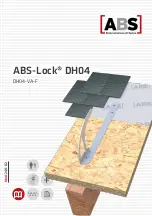
Page
5
of
63
3.0
Servicing
To be completed by Approved Service Engineer
Maintenance should be completed by an approved service engineer every 6 months to ensure the
products required standard is maintained. The service history of the product should be documented
each service.
When Servicing the Ceiling Track Hoist, ensure to fill out the Service Log which is located in the back
of the User Manual. When doing so, ensure the Serial Number of the Product and the User Manual
match up. Each Ceiling Track Hoist has its designated User Manual which is supplied to the User
during commissioning.
Component
Service/Inspection required
Generic:
Visual inspection of the externals of the Ceiling Track Hoist. Significant
damage that may affect the function of the Hoist along with a clear
safety hazard is unacceptable.
Check the Labelling on the Hoist to ensure they are all still legible, this
includes the Serial Number and other important markings.
Clean the Hoist at the end of each service. See User Manual for
cleaning details.
Check all main nuts and bolts, screws and fixing to see if they are
loose, if so tighten accordingly.
Lift Motor:
Inspect the components for damage that may affect the function and
safety of the product.
Listen for any unusual sounds when operating the Motor, this should
be done loaded and unloaded.
Fully Lift and Lower the Hoist to ensure that the Motor is performing
as intended. The lifting and lowering speed should be fairly consistent
throughout the motion of travel.
Ensure the Manual Emergency Lowering Device is performing.
Hub and Gearing:
Ensure that the Hub gearing is in good condition, excess wear should
be cleaning and an inspection on the condition must be conducted to
ensure the gearings are in a safe condition until the next service.
The Hub should be re-greased during service.
Ensure that the meshing of the Hub and Motor gearing is smooth.
Test the function of the Over-Speed Cam. Using a small Allen Key, place
it through the slot in the Chassis and test the functionality of the Cam
by pushing it outward. The Cam should automatically spring back to
position once the force has been removed.
Lift Tape:
Inspect the full length of the Lift Tape for any damage such as fraying.
See section 3.2 below as a reference for unacceptable wear.
There must be no signs of failure to the stitching of the Lift Tape, this
is most noticeable at the lowered where the Carry Bar is attached.
Toggle Switch:
Ensure that the Emergency Stop can be activated by pulling the E-
Lower Cord down one step. The operation should be smooth and can
be reversed when pressed back to the ON position.
Ensure that the emergency lower is functioning when activated. When
released it must become jammed in the E-Lower position.
Содержание TX440 Advanced PT
Страница 10: ...Page 10 of 63...
Страница 11: ...Page 11 of 63...






































